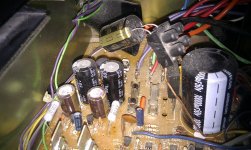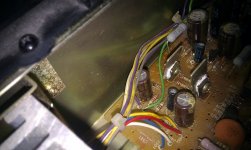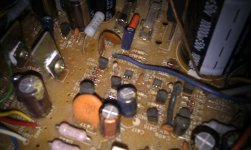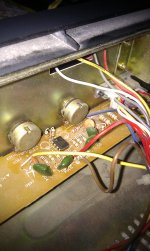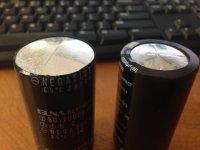If the caps are good quality and what they say they are (not fakes or anything) and they don't see an over voltage condition in use then I would say there is no real problem. I've seen many "bulged" caps when I worked as a repair tech and it doesn't necessarily mean there is a problem. Apart from overvoltage or excess ripple (and that would have to be so excessive that there would be other obvious issues such as rectifiers overheating, transformer overheating etc) there can't really be any other contributing factors. I bet its just a normal aging process of the caps "wrapper" or top piece.
You could always post a good picture showing just what you mean so we can be sure.
You could always post a good picture showing just what you mean so we can be sure.
Hi,
First photograph preamp section + a part of the right channel :
The big are Jamaicon 10K uF/50V + then bypass above in horizontal position : Panasonic FC 1200 uf/50V : notice the pure copper domini for easy tests... soldering give not better result !
On the right channel amp section : the 2 little blue caps are Panasonic FM, all the others (orange-brown negative marking) are Nichicon KZ Muse 100V (each are of the same values as the originals).
On the preamp section : the 2 first big filtering caps are the orginal Lelon (all the efforts to swap these 2 caps by Philips C136; Elna; etc, waste all the sounds qualities...)
The biggers caps of the preamp on the photograp are Silmic 1 as Silmic 2 give bad results ! on the midlle, the littliest caps with dark-blue marking are standard Jamicon ! cheaps and neutral
On the little pcb board oap+ pots : Silmic 1 are below the boards because their too much big diameter.
Sound improved dramaticly without loosing its musicality.
So the carefully next srep will be the LM oap vs the BB2604 tests (and the two others ref given in the other 2100 thread)
Interogations is about to swap the inputs signals wires between back & front of the case by modulation one like Cardas first price or cheaper Mogami... Another is : does the caps of the central protection circuit has an influence on the sound ?
but sound is not bad like that and it's a second system for occasional listening !
cheers,
hope this helps
First photograph preamp section + a part of the right channel :
The big are Jamaicon 10K uF/50V + then bypass above in horizontal position : Panasonic FC 1200 uf/50V : notice the pure copper domini for easy tests... soldering give not better result !
On the right channel amp section : the 2 little blue caps are Panasonic FM, all the others (orange-brown negative marking) are Nichicon KZ Muse 100V (each are of the same values as the originals).
On the preamp section : the 2 first big filtering caps are the orginal Lelon (all the efforts to swap these 2 caps by Philips C136; Elna; etc, waste all the sounds qualities...)
The biggers caps of the preamp on the photograp are Silmic 1 as Silmic 2 give bad results ! on the midlle, the littliest caps with dark-blue marking are standard Jamicon ! cheaps and neutral
On the little pcb board oap+ pots : Silmic 1 are below the boards because their too much big diameter.
Sound improved dramaticly without loosing its musicality.
So the carefully next srep will be the LM oap vs the BB2604 tests (and the two others ref given in the other 2100 thread)
Interogations is about to swap the inputs signals wires between back & front of the case by modulation one like Cardas first price or cheaper Mogami... Another is : does the caps of the central protection circuit has an influence on the sound ?
but sound is not bad like that and it's a second system for occasional listening !
cheers,
hope this helps
Attachments
Last edited:
Thanks for the pics. OK, the large 10K reservoir caps with the black plastic tops can appear bulged. The plastic often domes, but its not indicative of a problem.
All the other caps with the "slits" cut into the top of the can should never show any bulging, if they do then they need replacing.
All the other caps with the "slits" cut into the top of the can should never show any bulging, if they do then they need replacing.
All the caps were changeg but the two bigger for the amp section without the pre.
The two big are new: jamicon...i haven t the elna in 50v...jamicon are neutral.
But also the 2 lelon and the 4 caps of the speaker chip protection.
The two big are new: jamicon...i haven t the elna in 50v...jamicon are neutral.
But also the 2 lelon and the 4 caps of the speaker chip protection.
When it comes to choosing caps based on sonic qualities I'm afraid for the most part that I'm not a believer 😉 and good quality commercial grade is as high price wise as I'll go.
You must fit and use what you prefer though 🙂
You must fit and use what you prefer though 🙂
Here are the caps that I was concerned about. From left to right, a bulged Elna, a bulged Panasonic, and a new Panasonic.
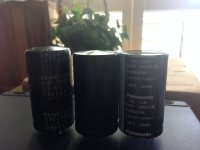
As I said before, the caps will bulge when placed in the C507 position, but the cap placed in the C508 position does not bulge. All of the caps measure within the 20% tolerance, I just find it odd that the caps placed in the C507 position will start to bulge.

As I said before, the caps will bulge when placed in the C507 position, but the cap placed in the C508 position does not bulge. All of the caps measure within the 20% tolerance, I just find it odd that the caps placed in the C507 position will start to bulge.
OK, I have to admit that is slightly strange. Why not strip the plastic wrapper and top off the two bulged ones and see what is underneath vent and pressure relief wise ?
Hi,
It is my experienced that when a capacitor bulged means 2 things. The capacitor it is over voltage or close to the working voltage or AC voltage it is applied to it. One test you can do for test for AC it is read the voltage with the voltmeter reading AC. As I mentioned above if the voltage applied to the capacitor close to the working voltage it will bulged also.
It is my experienced that when a capacitor bulged means 2 things. The capacitor it is over voltage or close to the working voltage or AC voltage it is applied to it. One test you can do for test for AC it is read the voltage with the voltmeter reading AC. As I mentioned above if the voltage applied to the capacitor close to the working voltage it will bulged also.
Not a believer myself...each layout needs some empirical tests.
No univetsal goods caps that works everywhere...but differences exist and are not just subtiles.
Think, this is each time global interactions...this is not the caps alone than you can hear.
No univetsal goods caps that works everywhere...but differences exist and are not just subtiles.
Think, this is each time global interactions...this is not the caps alone than you can hear.
FWIW, I'm measuring 0.01V AC and ~70V DC, depending on where my mains are at the time. I've seen this vary from 69.5 to 71.5.
The cap in question is rated for 80V.
The cap in question is rated for 80V.
Hi,
What was the original capacitors working voltage? Second. Where are you buying the capacitors? Last I would raise the working voltage to 100 volts and see what happen.
What was the original capacitors working voltage? Second. Where are you buying the capacitors? Last I would raise the working voltage to 100 volts and see what happen.
Original working cap from NAD service manual dictates 80V. I buy all my equipment from Mouser. The Elna caps came with the NAD when I purchased it, so I can't verify their authenticity, but the Panasonic caps are from Mouser.
Again, even with the bulge, they are measuring within spec, so I'm not yet willing to completely destroy a $10 cap...
Again, even with the bulge, they are measuring within spec, so I'm not yet willing to completely destroy a $10 cap...
Hi,
Also did you check the rectifier bridge for a shorted diode? That will caused what you are experiencing.
Also did you check the rectifier bridge for a shorted diode? That will caused what you are experiencing.
Caps don't feel hot, but I have not checked the diode yet.
I would have expected there to be a wildly varying DC voltage if the diode was shorted, but again - I'll pull it and double check.
I would have expected there to be a wildly varying DC voltage if the diode was shorted, but again - I'll pull it and double check.
I stripped the top off of the bulged caps, and the bulge is in the shape of the pressure relief. The relief is not cracked at all, so everything is contained. It seems to be the same on the Elna and the Panasonic.
Any ideas?
View attachment 430245
That does look suspicious. Lets look at the possibilities... and what is odd is that you say its always the same cap location of the pair that bulges.
You mentioned the bridge. The only thing that would make sense would be if one diode was failing open circuit (which would increase ripple current through the cap)... if it was failing short then so much current would flow that there would be other signs and symptoms. So an intermittent open bridge is one possible suspect. Even then its a tenuous suggestion. The ripple current would need to be several amps to exceed the caps rating and an amp that's idling or used for normal output doesn't draw that much current really.
Voltage. 70 volts across an 80 volt cap is fine. 80 volts is its working voltage, not some peak short term maximum. What causes pressure build up is heat, and that can come from excessive ripple current through the cap (bridge failure) or excess voltage above its limits that causes an increase in leakage current. One unlikely scenario... is there any possibility the voltage (mains) rises unexpectedly at certain times and you are not aware of that ? unlikely I guess.
- Status
- Not open for further replies.
- Home
- Amplifiers
- Solid State
- NAD 2100 DC Offset
